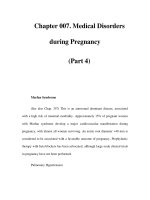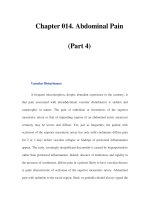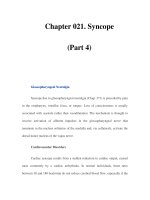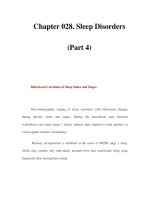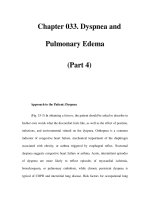Chapter 079. Cancer Genetics (Part 4) ppsx
Bạn đang xem bản rút gọn của tài liệu. Xem và tải ngay bản đầy đủ của tài liệu tại đây (54.48 KB, 5 trang )
Chapter 079. Cancer Genetics
(Part 4)
Familial adenomatous polyposis (FAP) is a dominantly inherited colon
cancer syndrome due to germline mutations in the adenomatous polyposis coli
(APC) tumor-suppressor gene on chromosome 5. Patients with this syndrome
develop hundreds to thousands of adenomas in the colon. Each of these adenomas
has lost the normal remaining allele of APC but has not yet accumulated the
required additional mutations to generate fully malignant cells (Fig. 79-2).
However, out of these thousands of benign adenomas, several will invariably
acquire further abnormalities and a subset will even develop into fully malignant
cancers. APC is thus considered to be a gatekeeper for colon tumorigenesis; Fig.
79-4 shows germline and somatic mutations found in the APC gene. The function
of the APC protein is still not completely understood but likely provides
differentiation and apoptotic cues to colonic cells as they migrate up the crypts.
Defects in this process may lead to abnormal accumulation of cells that should
normally undergo apoptosis and slough off.
Figure 79-4
Germline and somatic mutations in the tumor-
suppressor gene
APC. APC encodes a 2843-amino-
acid protein with 6 major domains: an
oligomerization region (O), armadillo repeats (ARM), 15-amino-
acid repeats (15
AA), 20-amino-
acid repeats (20 AA), a basic region, and a domain involved in
binding EB1 and the Drosophila discs large homologue (E/D).
Shown are the
positions within the APC
gene of a total of 650 somatic and 826 germline
mutations (from the APC database at
). The vast majority of these
mutations
result in the truncation of the APC protein. Germline mutations are
found to be relatively evenly distributed up to codon 1600 except for 2 mutation
hotspots at amino acids 1061 and 1309, which together account for one-
third of
the mutations found in famil
ial adenomatous polyposis (FAP) families. Somatic
APC
mutations in colon tumors cluster in an area of the gene known as the
mutation cluster region (MCR). The location of the MCR suggests that the 20-
amino-acid domain plays a crucial role in tumor suppress
ion. Note that loss of the
second functional APC
allele in tumors from FAP families often occurs through
loss of heterozygosity.
In contrast to FAP, patients with hereditary nonpolyposis colon cancer
(HNPCC, or Lynch syndrome) do not develop multiple polyposis but instead
develop only one or a small number of adenomas that rapidly progress to cancer.
HNPCC is commonly defined by family history, with at least three individuals
over at least two generations developing colon or endometrial cancer, and with at
least one individual diagnosed before the age of 50. Most HNPCC is due to
mutations in one of four DNA mismatch repair genes (Table 79-1), which are
components of a repair system that is normally responsible for correcting errors in
freshly replicated DNA. Germline mutations in MSH2 and MLH1 account for
>60% of HNPCC cases, while mutations in MSH6 and PMS2 are much less
frequent. When a somatic mutation inactivates the remaining wild-type allele of a
mismatch repair gene, the cell develops a hypermutable phenotype characterized
by profound genomic instability, especially for the short repeated sequences called
microsatellites. This microsatellite instability (MIN) favors the development of
cancer by increasing the rate of mutations in many genes, including oncogenes and
tumor-suppressor genes (Fig. 79-2). These genes can thus be considered
caretakers. Figure 79-5 shows an example of the instability in allele sizes for
dinucleotide repeats in the cancers of HNPCC patients.
Figure 79-5
Demonstration of microsatellite instability in normal and tumor tissue
from hereditary nonpolyposis colon cancer (HNPCC) patients. In each case the
lane marked T contains DNA from a t
umor, and the lane marked N contains DNA
from normal tissue of the same patient. The marker (D2S123
, located on
chromosome 2) is a microsatellite composed of a tandem repeat of the
dinucleotide CA, which varies in length from chromosome to chromosome.
Norm
ally, however, the length of the repeat is stable in somatic tissues. In this
example, a polymerase chain reaction analysis has been applied to genomic DNA,
and new alleles for the marker are apparent in tumors 1, 2, 5, and 7. Because the
tumor tissue is d
efective in DNA mismatch repair, clonal abnormalities in copying
of the CA repeat have arisen. Errors are also occurring in functional genes,
eventually resulting in the malignant phenotype. (
From LA Aaltonen et al, Clues
to the pathogenesis of familial co
lorectal cancer. Science 260:812, 1993, with
permission; Copyright 1993 AAAS.)

